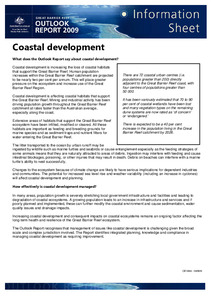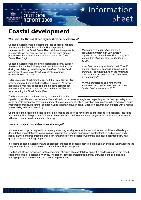Please use this identifier to cite or link to this item:
https://hdl.handle.net/11017/996Great Barrier Reef Outlook Report 2009: Coastal development information sheet

View this entry
Full metadata record
| DC Field | Value | Language |
|---|---|---|
| dc.date.accessioned | 2012-11-02T06:06:59Z | null |
| dc.date.available | 2012-11-02T06:06:59Z | null |
| dc.date.copyright | 2009 | en |
| dc.date.issued | 2009 | en-US |
| dc.identifier.uri | http://hdl.handle.net/11017/996 | null |
| dc.description.abstract | There are 72 coastal urban centres (i.e. populations greater than 200) directly adjacent to the Great Barrier Reef coast, with four centres of populations greater than 50 000. It has been variously estimated that 70 to 90 per cent of coastal wetlands have been lost and many vegetation types on the remaining dune systems are now rated as ‘of concern’ or ‘endangered.’ There is expected to be a 40 per cent increase in the population living in the Great Barrier Reef catchment by 2026. | en |
| dc.publisher | Great Barrier Reef Marine Park Authority | en |
| dc.relation.ispartofseries | Outlook Report 2009 | - |
| dc.title | Great Barrier Reef Outlook Report 2009: Coastal development information sheet | en |
| dc.type | Brochure | * |
| dc.subject.asfa | Marine parks | en |
| dc.format.pages | 1 | en |
| dc.contributor.corpauthor | Great Barrier Reef Marine Park Authority | en |
| dc.subject.apais | Sustainable development | en |
| dc.subject.apais | Environmental management | en |
| dc.publisher.place | Townsvilile | en |
| dc.subject.collection | Corporate Governance | en |
| dc.relation.connectiontogbrmpa | GBRMPA published this item | en |
| dc.subject.category | GBR outlook report | en |
| dc.subject.category | Information Publication Scheme | en |
| dc.subject.category | Climate change | en |
| dc.subject.location | Reef-wide | en |
| Appears in Collections: | Corporate | |
Files in This Item:
| File | Description | Size | Format | |
|---|---|---|---|---|
| Outlook-info-sheet-coastal-development.pdf | 78.25 kB | Adobe PDF |  View/Open |
Items in the ELibrary are protected by copyright, with all rights reserved, unless otherwise indicated.
